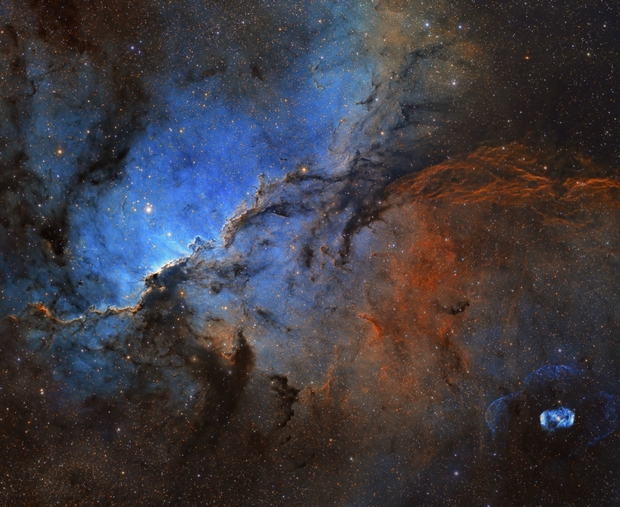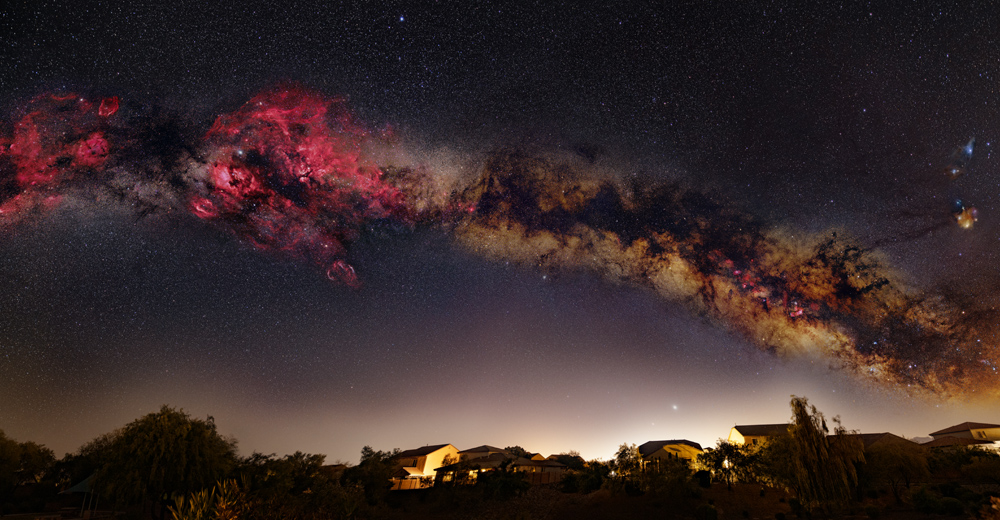Page 5 of 7
Re: Submissions: 2020 May
Posted: Wed May 20, 2020 7:01 pm
by paolodesalvatore
The Coma Cluster or Abell 1656, is a cluster of galaxies composed mostly of elliptical galaxies, located in the constellation of Chioma di Berenice and about 350 million light years away. In addition to the two central galaxies NGC 4874 and NGC 4889, there are thousands of smaller ones.
It is an area of the sky that is not very photogenic, but it gives a good idea of the vastness of the universe.
Data and hi res link:
 Coma Cluster - Abell 1656
Coma Cluster - Abell 1656 by
Paolo De Salvatore, su Flickr
Re: Submissions: 2020 May
Posted: Wed May 20, 2020 7:58 pm
by IO_12
М1 - Crab Nebula (NGC 1952, SN 1054) in Taurus
17 hours exposure time in Ha-OIII-SII-L-R-G-B
Copyright:
Velimir Popov, Emil Ivanov
The Crab Nebula, Messier 1 (M1, NGC 1952, SN 1054), is the most famous and conspicuous known supernova remnant, the expanding cloud of gas created in the explosion of a star as supernova which was observed in the year 1054 AD.
The Crab nebula and the pulsar at the center of this nebula are among the most important objects of modern astrophysics (Hester 2008). The Crab pulsar was observed for a first time in 1968 and represents a neutron star 28–30 kilometers across with a spin rate of 30.2 times per second, which emits pulses of radiation from gamma rays to radio wave.
The Crab Nebula is an extreme particle accelerator boosting the energy of electrons up to a few PeV (1015 eV), close to the maximum energy allowed by theory. The recent investigations reveal of ultra-high energy gamma-ray signal from the Crab Nebula up to 300 TeV. The Crab Nebula is unique, but not an archetypical representative of PWN (Pulsar Wind Nebula). Its pulsar is much more powerful than the pulsars of most of other PWNe and, surprisingly, the Crab Nebula is unusually compact. Crab Nebula is a rather inefficient gamma-ray emitter. The low IC (inverse Compton) radiation efficiency is compensated by the vast rotational power of the Crab pulsar. Therefore, despite the low efficiency, the Crab Nebula remains a very strong gamma-ray source. (Khangulyan et al., 2020).
Higher resolution: M1
The frames in Ha-OIII-SII-LRGB filters were taken with RC 12” astrograph, f/5 in LRGB, Bin 1 at #IRIDAobservatory:
Ha: 14x20 min, OIII: 12x20 min, SII: 12x20 min, L: 8x10 min, R: 6x10 min, G: 6x10 min, B: 6x10 min
Total 1020 min (17 hrs)
Thank you for looking ...
http://www.irida-observatory.org
Re: Submissions: 2020 May
Posted: Thu May 21, 2020 12:16 am
by cappellettiariel
Hi Everyone, good morning, I would like to share with you this image of NGC 3372 - Carina Nebula LRGB from skies bortle 9
8.4 h of total integration, from Córdoba, Argentina
Main Equipment: ZWO ASI 1600 mm-pro + SW Explorer 250pds + SW Coma Corrector 0.9x + EQ6-R-Pro + ZWO EAF + ZWO EFW 7x2"
Guiding equipment: guidescope Starguider 60/240 mm, ZWO ASI 120mm mini
*Gain 100, -25 º C, R-CCD 2" Svbony + L-Pro 2" Optolong, 43x120"
*Gain 100, -25 º C, G-CCD 2" Svbony + L-Pro 2" Optolong, 42x120"
*Gain 100, -25 º C, B-CCD 2" Svbony + L-Pro 2" Optolong, 44x120"
*Gain 100, -25 º C, L 2" Optolong + L-Pro 2" Optolong, 124x120"
50 Darks
50 Flats / filter
Polar Align: SharpCap 3.2
Acquisition: SGP 3.1
Processing: Pixinsight 1.8.8, PS
Hope you enjoy it, clear skies!

NGC3372 - Carina Nebula in LRGB from skies Bortle 9 by
Ariel Cappelletti, en Flickr
Re: Submissions: 2020 May
Posted: Thu May 21, 2020 4:49 am
by IO_12
NGC 7510 (Little Jewel Box) - an open cluster towards constellation Cepheus
Only 36 min exposure time in RGB
Copyright:
Velimir Popov, Emil Ivanov
Little Jewel Box
NGC 7510 is an open cluster, pretty rich, pretty compressed, with pretty bright stars. In IRIDA Observatory we decided to name it
Little Jewel Box because it resembles the
Jewel Box (Kappa Crucis Cluster or NGC 4755) in the constellation Crux (Crux Australis). For the northern hemisphere with latitudes higher than 40 degrees NGC 7510 is circumpolar and thus visible all night.
This young open cluster in the northern Galactic Plane is about 6 Myr old (Piskunov et al. 2004). The distance to NGC 7510 measured with precise astrometry by the second Gaia data release with a parallax of ~0.3 mas (milli-second of arc) is about 3.33 kpc or 10.9 kly (Cantat-Gaudin et al. 2020).
Higher resolution: NGC 7510
The frames in RGB filters were taken with RC 12” astrograph, f/5 in LRGB, Bin 1 at #IRIDAobservatory: R: 6 x 2 min (12 min), G: 6 x 2 min (12 min), B: 6 x 2 min (12 min)
Total exp. time only 36 min
Thank you for looking ...
http://www.irida-observatory.org
Re: Submissions: 2020 May
Posted: Thu May 21, 2020 7:48 am
by barretosmed
GABRIELA MISTRAL NEBULA
The green halo around the stars and because of my focuser that was releasing
BEST DETAILS
https://www.astrobin.com/full/lpns02/0/?nc=user
Equipment:
Apo ESPRIT 150mm
Qhy 16200a
22x 300 "Halpha and OIII
Cem60-EC Mount
DURING APRIL 2020
Jales - SP - Brazil
Processing and capture:
Software: Pixinsight, Adobe Photoshop, APT, PHD, Polemaster, SharpCap
Copyright: Fernando Oliveira de Menezes
Re: Submissions: 2020 May
Posted: Fri May 22, 2020 9:52 am
by yilun_ma
We could see Venus and Mercury coming very close to each other these days after sunset. The point source on the top right is Venus, the brightest planet seen from Earth, and the point source below it on the left is Mercury, the innermost planet in our solar system. It was just an amazing and spectacular experience to see the two planets being so close in the sky. Also, there is another thing worth noticing in the photo: we are able to see the phase of Venus - it looks like a crescent moon; I guess Copernicus and Galileo were right then~
 Venus-Mercury Conjunction
Venus-Mercury Conjunction by
Yilun Ma, on Flickr
Re: Submissions: 2020 May
Posted: Fri May 22, 2020 1:12 pm
by tommy_h
Ann wrote: ↑Wed May 20, 2020 5:50 pm
I absolutely love this image of circa 4 billion-year-old open cluster M67 and its many-colored stars. As a lover of all things blue, I am of course delighted to find a true blue B-type star, HIP 43465, a blue straggler, in this cluster (at bottom right). Note that there are a few other relatively blue stars in M67, and note the striking scarcity of blue stars in the field.
M67 rules, and this is a superb photo, Thomas!

Ann
Thanky you, Ann! I'm glad that you like this image!
Thomas
Re: Submissions: 2020 May
Posted: Fri May 22, 2020 2:50 pm
by Astro Tom
Pi Scorpii
12hrs of RGB with 2 hrs of Lum.
This object never gets higher than 19.5 degrees from my observatory, so this was a very tricky data capture and process.
FSQ106ED
Atik 11 Meg
Mesu 200
Tom O'Donoghue
www.astrophotography.ie
Re: Submissions: 2020 May
Posted: Fri May 22, 2020 6:18 pm
by felix_wegerer
Cygnus is rising high up in the northern hemisphere already.
This is a beautiful area of the sky. This image is taken a few days ago in Linz, a city in Austria. Under great light pollution through narrowband filters. Processed as HOO. Hope you like it, clear skies!
.
.
check out my
https://www.instagram.com/felix_wegerer/ for more!
Re: Submissions: 2020 May
Posted: Fri May 22, 2020 6:27 pm
by Kinch
IC 4603 & IC 4604
Full Info and Higher Resolution @
https://www.kinchastro.com/rho-ophiuchi.html
Re: Submissions: 2020 May
Posted: Fri May 22, 2020 9:18 pm
by felix_wegerer
Ann wrote: ↑Mon May 18, 2020 5:53 am
felix_wegerer wrote: ↑Mon May 11, 2020 9:36 pm
Heart and Fishhead Nebula 3 panel mosaic in SHO, taken in April 2020 from Linz, Austria. School Observatory. 30+h integration
Heart_Fish_SHO_crop.jpg
Hope you like it, clear skies!
Heart Nebula as a dog.png
Felix, that's a great mosaic of the Heart Nebula with superb detail.
Hope you don't mind that I see a dog in it!


Ann
Haha thanks, yeah you're right, could be a dog.

Re: Submissions: 2020 May
Posted: Sat May 23, 2020 7:20 am
by mos
NGC 6188 captured in SHO with a William Optics GT81 from a backyard in Wellington, New Zealand.
23.7 hours total integration time.
Full resultion and details on AstroBin
https://www.astrobin.com/jfhb1q/
https://cdn.astrobin.com/thumbs/de1iX56 ... XURFLk.jpg
Author: Matthew Sole
Re: Submissions: 2020 May
Posted: Sat May 23, 2020 12:14 pm
by Sebastian Voltmer
Mercury and Venus during daytime.
Both planets where captured with a C11 EdgeHD, a Baader FFC and an IR-pass filter.
Mercury was inserted into the frame of Venus in the correct size ratio as it appears in relation to Venus.
OTA: C11 EdgeHD
Amplification: Baader FFC
Camera: QHY5LII-M
Filter: IR-pass
Stack: 10,000 frames (30% each)
Location: Spicheren, France
Date: May 21, 2020
for APOD:
www.astrofilm.com
e-mail
sebastian@voltmer.de
Instagram:
www.instagram.com/sebastianvoltmer
Chreers,
Sebastian
Re: Submissions: 2020 May
Posted: Sat May 23, 2020 12:42 pm
by Robin_Onderka
A little touch from a mosaic I am planning for this region. Cygnus is very rich in nebulosity, in which North America nebula, Pelican nebula and Ha region around Sadr are the most recognizeable even in nightscape photography due to its unique shape and stronger response. Also the Crescent nebula put a little smile on my face when I saw it in my data as a little bonus

Photographed from: Beskid Mountains, Czech Republic
Gear: EOS 6D mod + Rokinon 135/2
5 lights: 60" f/2.4 ISO 1600
20 darks, 20 flats, 50 BIAS
Edt.: corrected "Beskid Mountains" in a location
 Clouds of Cygnus
Clouds of Cygnus by
Robin Onderka, on Flickr
Re: Submissions: 2020 May
Posted: Sun May 24, 2020 12:38 am
by SteveJ
Meteor train
Copyright: Steve Johnston
I’ve been going through some older images taken in 2016. The image shows the Milky Way, Saturn-Mars-Antares forming a triangle, green airglow, blue bioluminescence in the surf and in the upper left, a meteor train that I hadn’t noticed until now. Whilst I didn’t capture the meteor, the train persists for 9 frames or nearly 4 minutes and shows distortion and expansion in later frames. Meteor trains are considered to form at altitudes from 72 to 104 km, so assuming this train formed at the mid-height of 88 km, scaling directly off the image (ignoring that the train was not directly overhead) this train is nearly 40 km in length. Taken from Walkerville South, Victoria, Australia on 3 April 2016. Technical details: Single 25 second exposure, Canon 5DII, Samyang 14mm @ f2.8, ISO 6400.
Re: Submissions: 2020 May
Posted: Sun May 24, 2020 11:10 am
by IO_12
Comet C/2017 T2 (PANSTARRS) on 23.05.2020 near M 82 and M81
Copyright: Velimir Popov, Emil Ivanov
Irida Observatory
More info and hi-res images on
website
Re: Submissions: 2020 May
Posted: Sun May 24, 2020 1:16 pm
by mclane70
Comet C/2017 T2 Panstarrs meets M81 group.
56 hours of exposure since January
Comet taken at 1.23 a.m UTC+2 on 24th April 2020
360'' and 300' shots with QHY163M and 60'' shots with Canon 6D
Lens: 300mm Canon FD f/2.8 L on Cem 60
Elaboration Pixinsight and Photoshop.
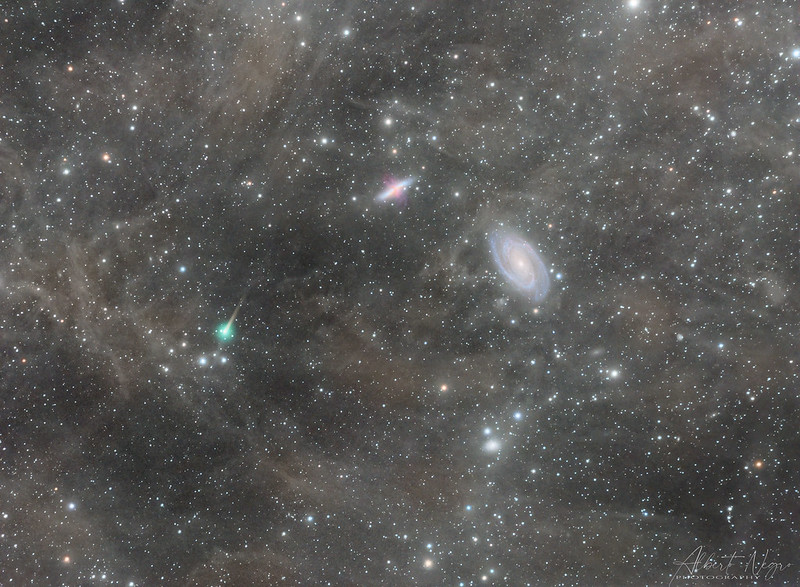 IFN2017T2FLICKR
IFN2017T2FLICKR by
Alberto Negro, su Flickr
Re: Submissions: 2020 May
Posted: Sun May 24, 2020 5:27 pm
by asymon
Milky Way over Tucson
http://www.woodlandsobservatory.com/index.htm
Copyright: Alistair Symon
Last year I completed a deep mosaic of the Northern Milky Way. In May this year I used a DSLR to take a 2 image Mosaic of the Milky Way rising over my observatory and the lights of Tucson Arizona. I then blended in the deep Milky Way to show a very detailed but technically accurate view of the night sky as my observatory was imaging Cygnus. The DSLR images were only 5 mins each but the Milky Way uses over 1000 hours of data from 4 different focal length telescopes and lenses taken with H-alpha and LRGB filters. You can see a higher resolution here:
http://www.woodlandsobservatory.com/Mil ... ry2020.htm
Re: Submissions: 2020 May
Posted: Sun May 24, 2020 5:34 pm
by Robin_Onderka
Clouds of Cygnus (final)
A complete mosaic of this region. First, I was worried about not being able to stack all the mosaic panels into this piece, but it worked and I am so happy with it!
Cygnus is very rich in nebulosity, in which North America nebula, Pelican nebula and Ha region around Sadr are the most recognizable even in nightscape photography due to its unique shape and stronger response. The remarkable shape located on a bottom right are supernova remnants, known as Cygnus Loop (or Veil Nebulae). Also the Crescent nebula put a little smile on my face when I saw it in my data as a little bonus

Photographed from: Beskid Mountains, Czech Republic
Gear: EOS 6D mod + Rokinon 135/2
10 panels - 5 lights each
60" f/2.4 ISO 1600 | 20 darks, 20 flats, 50 BIAS
SW: Astro Pixel Processor, Photoshop
 Clouds of Cygnus (final)
Clouds of Cygnus (final) by
Robin Onderka, on Flickr
Re: Submissions: 2020 May
Posted: Sun May 24, 2020 10:16 pm
by mdione
http://dionecanali.hd.free.fr/~mdione/P ... .17_01.jpg
Moon, Mercury and Venus on May 24th, 22h, North of Antibes. We see the last lights of Antibes in the foreground, Grasse at the feet of the mountains, and the pointy top of Le Doublier as the last silhouette of Earth before the sky and space. I took the picture from one of my apartment's windows while waiting for my kids to fall asleep for the night. Not much equipment was required, a tripod, a camera, and a way to take photos without touching the camera (I used a computer, a USB cable and gpoto2

Re: Submissions: 2020 May
Posted: Mon May 25, 2020 2:36 am
by leemr
IC 2944 in H and O, with RGB star colour.
Larger version available
here
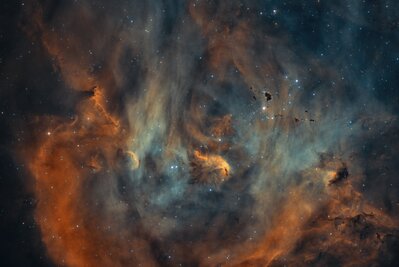
- IC 1944
Re: Submissions: 2020 May
Posted: Mon May 25, 2020 7:21 am
by andrewsteele
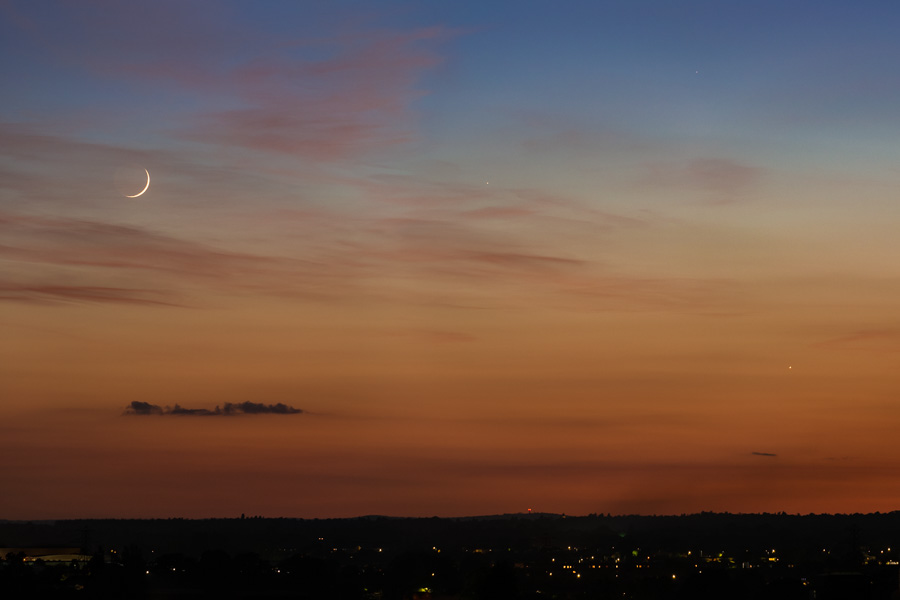
Larger version:
https://andrewsteele.co.uk/r/apod/2020- ... steele.jpg
Crescent Moon on the left, Venus on the right (also a crescent if you look closely) and tiny speck Mercury in the middle, all setting in the west just over an hour after sunset on 24th May 2020. Photo taken in Slough, near London, UK.
Re: Submissions: 2020 May
Posted: Mon May 25, 2020 3:07 pm
by aradiel
Deepness Dawn, a Reboot
www.christopheanagno.com
Copyright: Christophe Anagnostopoulos
Location: Antiparos Island, Cyclades Region, Greece
The night sky is always magical!
The experience of seeing the galactic core with your naked eyes is so amazing!
In this image, the viewer can see many celestial objects, like the bright Jupiter on the left and the faint Saturn on the far left. On the right is the bright Antares on the colorful Rho Ophiuchi region, while in the middle the viewer can feel the awe in front of the enormous Galactic Core.
Normally (meaning before the global pandemic) at this time of year, the small town on the right would have a lot of residents and its lights would block a lot of the view to the night sky, but due to covid-19 travel restrictions, its nearly empty and thus we can enjoy the beauty of the night sky.
For this shot, I used my favorite astro lens, the Tokina Firin 20mm F/2 AF with my Nikon Z6 (via Techart TZE-01 adapter).
In front of the lens there was a Hoya Starscape Light Pollution Filter in order to enhance the saturation of the nebulocity in the core and in the Rho Ophiuchi region.
Lastly, a Slik ECH-630 Star Tracker was used to achieve sharp longer exposures.
Running chicken nebula in Ha and OIII
Posted: Mon May 25, 2020 7:34 pm
by aldomottino
Copyright: Aldo Mottino
Re: Submissions: 2020 May
Posted: Mon May 25, 2020 10:08 pm
by Iaffaldano Giuseppe Carmine
 Coma Cluster - Abell 1656 by Paolo De Salvatore, su Flickr
Coma Cluster - Abell 1656 by Paolo De Salvatore, su Flickr Coma Cluster - Abell 1656 by Paolo De Salvatore, su Flickr
Coma Cluster - Abell 1656 by Paolo De Salvatore, su Flickr




